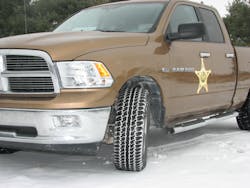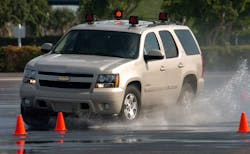All-Season vs All-Terrain Tires for Police SSV
The tires that come as original equipment (OE) on Special Service Vehicle (SSV) pickups and SUVs are retail-oriented. The police department can make improvements in tire performance by selecting a different tire when the OE tires wear out.
Often, the OE all-season tires are so bad, the police department overcompensates and selects a replacement tire that is too aggressive. Since all tires are a compromise, that resulting tire may give up a lot in many areas to make gains in a few. The department may not realize the poorer dry traction, wet traction, tire life, fuel economy and even snow performance.
There are many patrol scenarios where a good all-season tire is better for the pickup/SUV, and patrol scenarios where a good all-terrain tire is preferred. All-season and all-terrain are not tire marketing terms. Instead, they are descriptions of two different tires with two different tread compounds designed for two different driving environments.
Neither tire does great in the scenarios calling for the other.
High silica vs. high carbon black
All-season tires provide good traction under the majority of driving conditions including wet and wintery weather, and on both paved and gravel-stone roads. The all-season tire is the ultimate compromise—it gives up the least to gain the most.
The all-terrain tire is built for a combination of paved road and off-road driving. This includes extensive driving on gravel-stone roads, and on dirt, sandy or rocky trails. The on-road/off-road all-terrain tire is not a winter snow tire and it is not an off-road mud-terrain tire.
All-season tires have a tread compound with a high silica content. The silica filler helps the tire compound remain elastic and flexible at low temperatures, which gives better grip and braking under wet and winter conditions. In fact, silica can improve wet handling by 15 percent.
The downside to a high silica tire is that sharp stone and other unpaved road conditions can cut and slice the tread compound. Called chip and tear, these are micro cuts, small flakes or even big sections of rubber that are cut or torn off the tread. Chunking is simply tearing away large chips.
All-terrain tires have a tread compound with a high carbon black content. Carbon black makes the tire compound harder and stiffer. It makes the tread cut, chip and tear resistant, and chunk and abrasion resistant. Carbon black helps the tire to be tougher and more durable under unpaved or off-road conditions that would chip, tear, shred and flake a high silica all-season tire.
As a rule, all-season tires have high silica content and all-terrain tires have high carbon black content. However, exceptions exist. One make of tire has an all-terrain block tread pattern but uses all-season tire compounds. On these, the tread gets chewed up right away by gravel-stone roads.
It is easy to determine if an all-season tire is not the best choice for the patrol area. The SSV pickup or SUV comes with all-season tires. The tire wear on an unpaved road has a very distinctive wear pattern. If the gravel-stone roads or off-road surfaces have cut, torn or chunked that all-season tire, then an all-terrain tire is the best replacement choice.
If the road conditions have not pulverized the all-season tread, then upgrading to a higher rated all-season tire is a better option than going to an all-terrain tire.
Chewed up tread? Go all-terrain.
Smooth treadwear? Stay all-season.
All-terrain tire for snow?
On dry pavement, the all-season tire has better traction than the all-terrain tire and much better performance on wet pavement. All-season tires have a larger contact patch with the road than the wide-open tread pattern of all-terrain tires. High silica all-season tires have softer and more pliable tire compounds than high carbon black compounds in all-terrain tires and conform better to the micro road surfaces.
A good all-terrain tire is not necessarily a good winter snow tire, even though it has a wide-open tread pattern like a snow tire. For several reasons, a good all-season tire has equal and often better performance in both shallow and deep snow than a good all-terrain tire.
First, the compound. Carbon black added to the tread compound of the all-terrain tire makes the tread blocks hard and stiff. The best snow traction comes from tread blocks that are flexible and pliable especially in low temperatures. The high silica, all-season tire starts off softer and stays softer as the temperature drops.
Second, the tread pattern. The all-terrain tires use solid tread blocks. The all-season tires have a number of cuts or sipes in the tread. Sipes are designed to open, fill with snow and then trap that snow. Tire tests have proven that under some conditions, i.e. wet snow, the snow-packed sipes offer more traction than the grooves in the tread. In other words, snow-on-snow produces more traction than rubber on snow.
Up to 50 percent of tire performance during wet snow, icy snow and mirror ice conditions comes strictly from the sipes. They play a lesser but still significant role during the other adverse conditions of fresh snow, deep snow and packed snow. Snow traction comes from these sipes. Winter snow tires and all-season tires have a lot. All-terrain tires don’t have any.
The best snow traction comes from when the snow is kept in the tread, not when the snow is ejected from the tread. The worst snow tires are the mud-terrain tires designed to dig in and sling out mud. Tires that keep the snow packed into the tread provide better traction than tires that eject the snow from the tread. The all-season tires have a double advantage over the all-terrain tires in snow—the softer compound and the mechanical action of the sipes in the tire pattern.
Tire Rack tests
Tire Rack conducted a series of all-season tire versus all-terrain tire tests on wet, dry and snow-covered surfaces using two benchmark tires. The General Grabber HTS 60 represented the typical all-season tire while the General Grabber AT 2 represented the typical all-terrain tire.
On the dry track, the all-season tire gave 4 percent better performance than the all-terrain. With more surface area in the contact patch from a closed tread pattern, the all-season tire had better slalom times, better lap times, greater cornering and shorter ABS controlled stopping distances. The results were close but definitely not a tie. Differences greater than 2 percent can be felt by any well-trained driver. To an EVOC instructor or autocross competitor, the 1-second difference on a 33-second course is a huge margin of victory.
On the wet track, there were even greater differences between all-season and all-terrain tires. The more pliable tread compound in the all-season tire gave 10 percent better performance than the harder tread compound in the all-terrain tire. For example, from 50 mph, the all-season tire stopped one car-length shorter than the all-terrain.
Tire Rack does winter testing at a track in northern Sweden specifically designed for winter tire tests. On a snow-covered track, they measured traction control engaged acceleration, ABS-activated braking and the road course lap times.
On the snow, the all-season tire gave over 12 percent better performance than the all-terrain, including almost 20 percent shorter stopping distances. For all the attention that traction from a stop gets, shorter braking distances in the snow are much more important.
In 500 miles of state highway and county roads, Tire Rack found the all-season tire gave 3.2 percent better fuel economy than the all-terrain tire. The blocky, open tread pattern of the all-terrain tire simply requires more energy to roll it down the road.
Even if there is some driving calling for an all-terrain tire, it still may not be the best overall choice. “It is like a police officer carrying a shotgun all the time for the rare time when it is the best option,” says Woody Rogers, director of tire information services at Tire Rack. Rogers conducts their extensive tire testing program.
County patrol
We verified Tire Rack’s objective, all-terrain versus all-season test results with our own subjective, long-term driving impressions using one of our RAM 1500 SSV trucks. The patrol jurisdiction is very rural with 52 percent paved roads and 48 percent gravel-stone roads. Most calls for service go to population centers with paved roads, but deputies still log 25 percent of the time on gravel stone. Those percentages favor an all-terrain tire.
We replaced the worn-out OE tires and put 10,000 miles on a set of Firestone all-terrain tires for a wet fall season and half of the snowy winter. We then installed a set of Firestone all-season tires for another 10,000 miles for the rest of the winter and the early wet spring.
Among the brands of replacement tires typically purchased by police fleet managers, one of the highest rated all-season tires is the Firestone Destination LE 2. Of the 32 different all-season tires sold by Tire Rack, the Destination LE 2 ranks sixth overall. Of the frequently purchased brands, one of the highest rated all-terrain tires is the Firestone Destination A/T. Of the 17 different all-terrain tires, the Destination A/T ranks third overall.
Under dry conditions, we had very few ABS-activated stops and wheel-spinning starts. We did, however, corner at close to the limit with both tires. We found the dry performance to be a toss-up. There was more tire noise and a harsher ride with the all-terrain tires, but Noise, Vibration and Harshness (NVH) are not a big deal in a police truck.
We found the wet performance of the all-season tires to be better than the all-terrain tires. When driving in 2WD, unintended wheel spin with the all-terrain tire was an issue. The ABS activated more often with the all-terrain tires under heavy braking while turning. The all-season tires felt much more responsive during hard cornering in the wet. In the wet, slushy snow, packed snow and deep snow drifts we expected differences between the tires, but it was another toss-up. In the deepest snow, and on snow-covered gravel, the all-terrain tires did slightly better than the all-season tires. In wet snow, packed snow and on snow-covered pavement, the all-season tires did slightly better.
For law enforcement, the best evidence for deciding between all-season and all-terrain comes when the worn-out OE all-season tires are removed—just look at the tire wear.
About the Author
Lieutenant Sanow is the director of training with the Benton County Sheriff’s Department (Ind.). He is an original member of the Dodge and Chevrolet police advisory boards and has served on the Ford police advisory board. He may be reached at [email protected].

